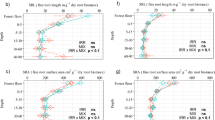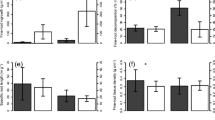Abstract
Little is known about below-ground competition between different tree species in mixed forests. We investigated the evidence for asymmetric competition between fine roots (<2 mm) of adult European beech (Fagus sylvatica) and sessile oak (Quercus petraea) trees in a mixed temperate beech-oak forest by (1) conducting fine-root growth experiments in the field (root chamber technique), (2) comparing the fine-root mass of two-species and monospecific plots, and (3) analysing the density and overlap of beech and oak root systems in shared soil volumes. Field experiments with root chambers, which allow fine-root endings to grow under controlled conditions for several months, showed that beech grew more rapidly than oak roots when both species were grown together. In the mixed beech-oak wood, where stem densities and leaf areas of the two species were similar, beech outnumbered oak three- to five-fold in fine-root biomass, and root tip and ectomycorrhiza numbers, which led to a much greater root:shoot ratio (root area index:leaf area index, RAI:LAI) for beech (3.9) than oak (1.7). The remarkably small fine-root biomass of oak was attributed to competitive replacement by beech roots as indicated by comparison with monospecific oak wood. Although oak had much less fine-root mass than beech, oak outnumbered beech in the coarse root fraction (2<d<5 mm) resulting in a greater fine root:coarse root ratio in beech than oak. The fine-root systems of the two species completely overlapped in the nitrogen-rich organic topsoil but differed with respect to their horizontal distribution patterns: beech root biomass increased with increasing distance from a beech stem whereas oak root mass was not dependent on stem distance. Beech (but not oak) root mass was correlated with the thickness of the organic topsoil horizons which, at average, were thicker at greater distances from beech stems. We conclude that beech fine roots colonise nitrogen-rich patches in the organic horizons of this forest more successfully than do oak roots. Our results (root chamber experiments, oak root abundance in mixed vs. monospecific wood, beech root dominance in the organic topsoil) suggest that asymmetric interspecific root competition in favour of beech exists in this stand.
Similar content being viewed by others
Author information
Authors and Affiliations
Rights and permissions
About this article
Cite this article
Leuschner, C., Hertel, D., Coners, H. et al. Root competition between beech and oak: a hypothesis. Oecologia 126, 276–284 (2001). https://doi.org/10.1007/s004420000507
Received:
Accepted:
Published:
Issue Date:
DOI: https://doi.org/10.1007/s004420000507




